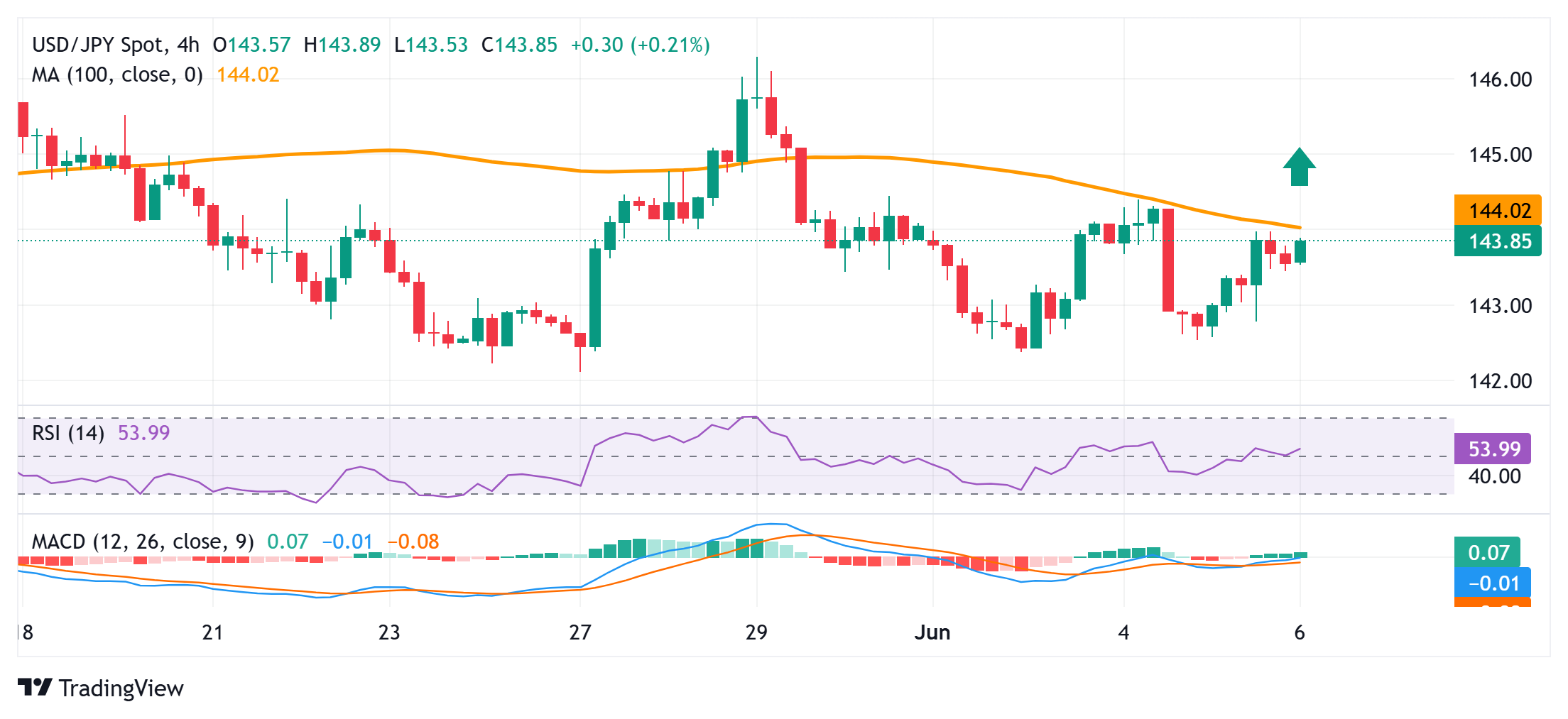USD/JPY climbs to 144.00 amid modest USD strength
- The Japanese Yen attracts sellers for the second straight day in reaction to disappointing domestic data.
- The optimism over the resumption of US-China trade talks further undermines demand for the safe-haven JPY.
- The divergent BoJ-Fed expectations should limit JPY losses and cap USD/JPY ahead of the US NFP report.
The Japanese Yen (JPY) builds on its steady intraday descent, which, along with the emergence of some US Dollar (USD) buying, lifts the USD/JPY pair to the 144.00 neighborhood, heading into the European session on Friday. The disappointing release of Japan’s Household Spending data comes on top of a fall in Japan’s real wages for the fourth consecutive month and concerns that global trade tensions may weaken wage momentum. This, in turn, might complicate the Bank of Japan’s (BoJ) efforts to normalize monetary policy, which, along with hopes for the resumption of US-China trade talks, continues to weigh on the safe-haven JPY.
Market participants, however, are still pricing in the possibility that the BoJ will continue raising interest rates this year amid the broadening inflation in Japan. Furthermore, persistent geopolitical risks might keep a lid on any market optimism and help limit deeper JPY losses. Meanwhile, a modest USD uptick could be attributed to repositioning trades ahead of the key US Nonfarm Payrolls (NFP) report and is likely to remain limited amid bets that the Federal Reserve (Fed) will lower borrowing costs further. Apart from this, worries about the worsening US deficit outlook should contribute to capping the Greenback and the USD/JPY pair.
Japanese Yen retains negative bias on the back of weaker domestic data, positive risk tone
- Government data released earlier this Friday showed that Japan’s Household Spending unexpectedly fell by 0.1% from a year earlier in April as compared to the 2.1% increase recorded in the previous month. On a monthly basis, spending declined more than anticipated, by 1.8% during the reported month.
- The monthly wage data released on Thursday showed that real wages in Japan fell for a fourth consecutive month in April as rising prices continued to outpace pay hikes. This could further undermine private consumption, which contributes to over 50% of Japan’s GDP, and trigger an economic recession.
- The US Treasury Department, in its exchange-rate report to Congress, said on Thursday that the Bank of Japan should continue to proceed with monetary tightening. The report argued that doing so would support a healthier exchange rate and facilitate needed structural adjustments in trade flows.
- Japan reportedly is softening its stance on the 25% US auto tariff and instead is proposing a flexible framework to reduce the rate based on how much countries contribute to the US auto industry. Japan’s chief tariff negotiator, Ryosei Akazawa, is in Washington for the fifth round of talks with US officials.
- Meanwhile, US President Donald Trump and Chinese President Xi Jinping spoke on Thursday and agreed that officials from both sides will meet soon for more talks to resolve the ongoing trade war. Trump said that the call was focused almost entirely on trade and resulted in a very positive conclusion.
- The US Dollar remains close to its lowest level since April 22 touched the previous day amid increasing odds of an interest rate cut by the Federal Reserve in September. Traders, however, seem reluctant to place aggressive bets around the USD/JPY pair ahead of the US Nonfarm Payrolls (NFP) report later today.
USD/JPY could accelerate the intraday move higher once the 144.00 hurdle is cleared

From a technical perspective, the USD/JPY pair has been oscillating in a familiar range since the beginning of this week, forming a rectangle on the daily chart. Against the backdrop of the downfall from the May monthly swing low, this might still be categorized as a bearish consolidation phase. Moreover, slightly negative oscillators on the daily chart suggest that the path of least resistance for spot prices is to the downside. Hence, any further move up is more likely to attract fresh sellers near the 144.00 round figure.
This is followed by the weekly high, around the 144.40 region. The latter coincides with the 100-period Simple Moving Average (SMA) on the 4-hour chart, which if cleared might shift the bias in favor of bullish traders and allow the USD/JPY pair to reclaim the 145.00 psychological mark.
On the flip side, weakness below the 143.50-143.45 area could be seen as a buying opportunity near the 143.00 round figure. Some follow-through selling, leading to a subsequent slide below the 142.75-142.70 region, could make the USD/JPY pair vulnerable to accelerate the downfall to the 142.10 region, or last week’s swing low. A convincing break below the latter could make spot prices vulnerable to the recent downward trajectory and slide further to the next relevant support near the 141.60 area en route to sub-141.00 levels.
US Dollar PRICE Today
The table below shows the percentage change of US Dollar (USD) against listed major currencies today. US Dollar was the strongest against the Japanese Yen.
| USD | EUR | GBP | JPY | CAD | AUD | NZD | CHF | |
|---|---|---|---|---|---|---|---|---|
| USD | 0.12% | 0.06% | 0.32% | -0.07% | 0.17% | -0.11% | 0.17% | |
| EUR | -0.12% | -0.05% | 0.16% | -0.18% | -0.00% | -0.22% | 0.05% | |
| GBP | -0.06% | 0.05% | 0.23% | -0.12% | 0.06% | -0.15% | 0.11% | |
| JPY | -0.32% | -0.16% | -0.23% | -0.34% | -0.03% | -0.31% | -0.21% | |
| CAD | 0.07% | 0.18% | 0.12% | 0.34% | 0.24% | -0.03% | 0.23% | |
| AUD | -0.17% | 0.00% | -0.06% | 0.03% | -0.24% | -0.22% | 0.06% | |
| NZD | 0.11% | 0.22% | 0.15% | 0.31% | 0.03% | 0.22% | 0.26% | |
| CHF | -0.17% | -0.05% | -0.11% | 0.21% | -0.23% | -0.06% | -0.26% |
The heat map shows percentage changes of major currencies against each other. The base currency is picked from the left column, while the quote currency is picked from the top row. For example, if you pick the US Dollar from the left column and move along the horizontal line to the Japanese Yen, the percentage change displayed in the box will represent USD (base)/JPY (quote).







